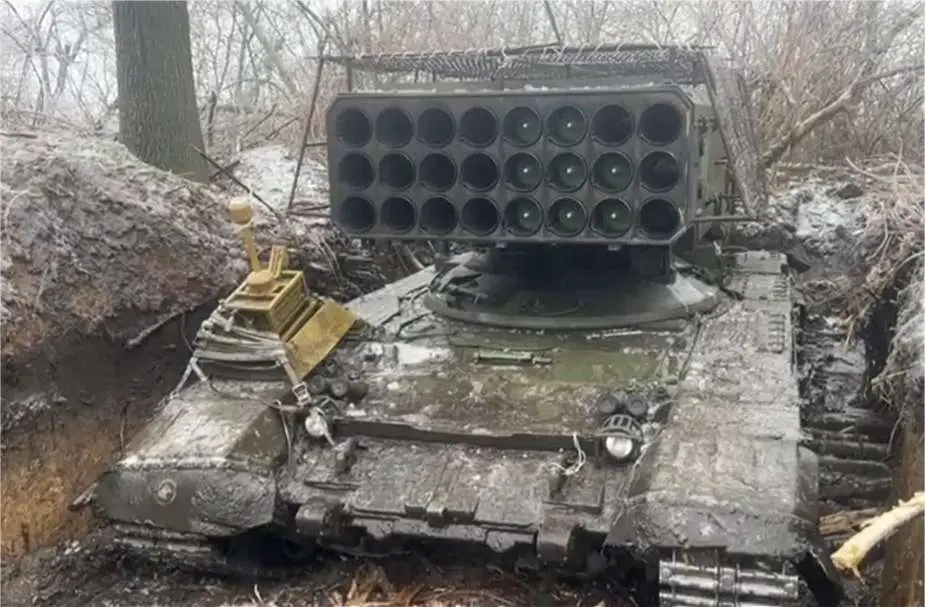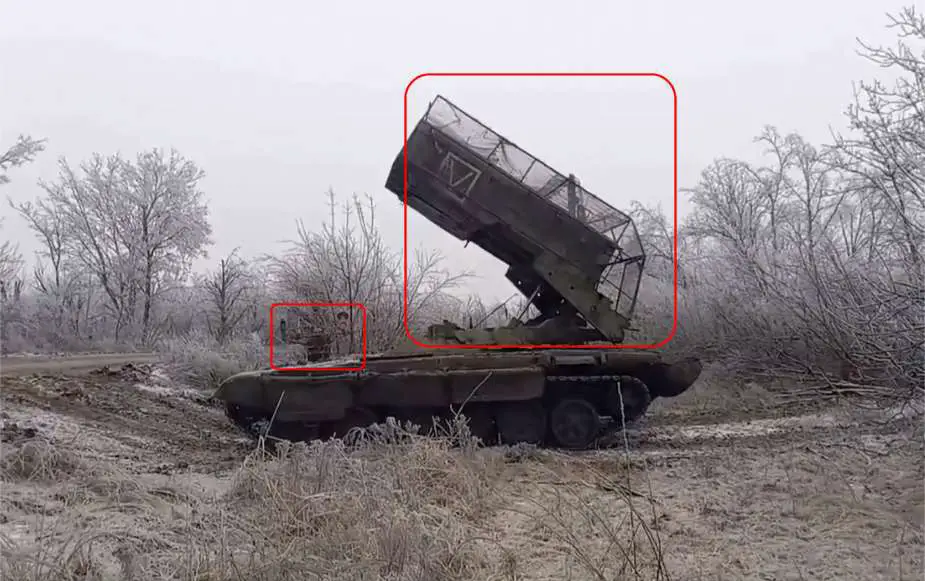- Army
- Conflicts in the world
- Israel - Iran conflict 2025
- Pakistan - India Conflict 2025
- Russia Ukraine War 2022
- Libya conflict day by day
- HAMAS - Israel War 2023
- Operation Serval in Mali French Army
- Sangaris operation Central African Republic
- Sangaris opération militaire République Centreafrique
- Ukraine - Russia conflict
- Syria conflict news
- Defence & Security Industry Technology
- Armies in the world
- Analysis Defense and Security Industry
- Conflicts in the world
- Navy
- Air
Russian Forces Ramp Up TOS-1A Defenses in Ukraine with Advanced Jamming Tech and Enhanced Armor
To enhance the protection of the TOS-1A, one of the most powerful artillery systems in the Russian armed forces, Russian soldiers have implemented additional measures while deployed in Ukraine. These include the installation of the P-377UVM1L 'Lesochek' jamming station on the TOS-1A units. This advanced jamming station is specifically designed to counter the threats posed by loitering munitions and First-Person View (FPV) drones. Alongside this technological upgrade, the TOS-1A has also been outfitted with wire cage armor around its rocket launcher station.
Follow Army Recognition on Google News at this link

Russian army TOS-1A heavy flamethrower rocket launcher equipped with P-377UVM1L 'Lesochek' jamming station and cope cage armor. (Picture source Social Network VK)
The Ukrainian battlefield has seen significant developments with the use of loitering munitions, commonly known as "kamikaze drones," and First-Person View (FPV) drones. These technologies have introduced new dynamics and threats in the conflict.
Loitering munitions, or kamikaze drones, are weapons that patrol over the battlefield before self-destructively attacking a target. Combining intelligence, surveillance, reconnaissance, communication, and strike capabilities, these drones date back to the 1980s when Israel developed the Harpy loitering munition. Both Russia and Ukraine have successfully used them in the current conflict. Chinese strategists, observing the conflict, note that despite their small size, these munitions have achieved significant results, particularly in destroying high-value targets like air defense radars and missiles. They are viewed as cost-effective in the large-scale war of attrition, attracting global interest in their development and countermeasures.
These munitions have been employed for various combat missions in Ukraine, including the suppression of enemy air defenses, counter artillery operations, and targeting armored vehicles. The effectiveness of loitering munitions in these roles is influenced by their material composition, size, speed, and radar signature. However, they face challenges in destroying heavily armored targets like main battle tanks.
FPV drones, particularly utilized by Ukrainian soldiers, are a significant aspect of the country's drone warfare assets. These drones empower infantry formations, offering tactical advantages on the battlefield. Ukraine's Ministry of Digital Transformation, which oversees the country's drone program, focuses on using cost-effective drones to destroy more expensive enemy assets. The FPV drones are versatile, capable of targeting a wide range of objectives, including individual soldiers, artillery crews, and radar systems.
Their strengths lie in cost-effectiveness, mass production, and the ability to track moving targets. Additionally, they can be operated autonomously by smaller units without the need for coordination with higher command levels. FPV drones use payloads like RPG-7 rounds, enabling them to damage tanks or destroy various military assets. However, they also have specific limitations, including the high cost of pilot training, lower reliability due to manual assembly, and variability in component quality.
Ukraine has significantly increased its use of FPV drones, with their role growing on the battlefield. While they are cheaper and faster to produce than alternatives like Mavic drones, their combat effectiveness varies. They are more suited for attacking personnel, artillery positions, and firing points rather than heavily armored vehicles like tanks. FPV drones are also somewhat resistant to electronic warfare systems, offering flexibility in control and video transmission frequencies.
In response to the evolving threats on the battlefield, particularly from loitering munitions and First-Person View (FPV) drones, Russian military forces have increased the protection of their combat vehicles through the implementation of "cope cages" and additional armor enhancements.

The Russian TOS-1A is fitted with cope cage armor mounted around the rocket launcher station and P-377UVM1L 'Lesochek' jamming station located at the front right side of the hull. (Picture source Social Network VK)
The "cope cage" is a type of protective structure that has been added to Russian armored vehicles, including main battle tanks such as the T-80BVM, T-72B3M, and T-90M, as well as other combat vehicles like the TOS-1A thermobaric rocket launchers and Soviet-era T-62 tanks. These cages, which started appearing in late 2021, are designed to counter the threat of loitering munitions and drones, which have proven effective in conflicts like the 2020 Nagorno-Karabakh War. The cages are made up of metal grids or screens that provide a physical barrier against drone attacks from above, though their effectiveness against anti-tank guided missiles has been debated.
The design of these cages varies, with some configurations including more supporting tubes and extensive corrugated metal. In addition to the cages, some tanks have been equipped with layers of Explosive Reactive Armor (ERA). This ERA is intended to detonate upon impact, creating a counter-blast that defends against armor-penetrating weapons before they can penetrate the tank's turret or hull. However, the effectiveness of this combination of cope cages and ERA is still a matter of debate.
Additionally, some Russian combat vehicles have been observed with factory-produced camouflage wraps, which are believed to help conceal the vehicle's heat signature from infrared sensors. This development indicates a move towards more integrated and advanced protection systems for combat vehicles.
Despite these enhancements, there have been operational challenges and criticisms. Some Russian tank crew members have reported issues with these additions, such as interference with machine gun movement, radio communication problems, and difficulties in evacuating the tank in case of fire.
In this case the TOS-1A was also equipped with the P-377UVM1L "Lesochek" jamming station designed to counter the growing threat of unmanned aerial vehicles (UAVs) in modern warfare. The 'Lesochek' system employs sophisticated technology to create wide-band barrier interference, effectively disrupting the navigation and geopositioning channels of enemy drones. With its capability to create an informational blockade extending up to 100 meters horizontally and 200 meters vertically, the system plays a crucial role in safeguarding the combat formations of both offensive and defensive military units. This development marks a pivotal step in enhancing battlefield tactics and strategies, offering a robust defense against the increasingly sophisticated use of UAVs in military conflicts.
The TOS-1A holds a crucial position in the Russian military's artillery capabilities, particularly in the context of the conflict in Ukraine. As a heavy flamethrower system, it is designed for delivering thermobaric rockets that are capable of causing substantial destruction over a wide area. This makes the TOS-1A highly effective against a range of targets, including fortified positions, enemy personnel, and light armored vehicles. Its role is not just limited to causing physical destruction; it also has a significant psychological impact on the battlefield. The fear and demoralization resulting from its deployment can be a decisive factor, influencing the morale and combat effectiveness of opposing forces.
Given its strategic value, protecting the TOS-1A becomes a priority for Russian forces. The system's effectiveness in disrupting enemy lines and inflicting substantial damage makes it a prime target for countermeasures by opposing forces. In response, Russia has implemented various defensive strategies, such as the use of 'cope cages' and other armor enhancements, to shield these vital assets from potential threats like anti-tank guided missiles and drone attacks. These protective measures are not just about safeguarding the hardware; they are integral to maintaining the operational capability and effectiveness of the TOS-1A on the battlefield.
News Russia Ukraine War


























